Nostr, Bitcoin Inscriptions, and the First Amendment.

Dawn of a New Era for Free Speech
January, 2023 was a watershed moment for anonymous speech.
That month, two seemingly unrelated technological innovations exploded onto the internet: the open-source Nostr protocol (Notes and Other Stuff Transmitted by Relay) and Bitcoin Inscriptions. While architecturally different (Nostr is a stand-alone internet protocol akin to HTTP; Inscriptions are a specific utilization of an existing internet protocol, i.e., Bitcoin), these innovations both enable forms of anonymous communication. This has profound First Amendment implications.
As I argued in the most recent print edition of Bitcoin Magazine, the First Amendment includes the right to speak confidentially, it protects anonymous speech, and it prevents compelled disclosure of those with whom one associates and speaks.1 Moreover, the right to speak and associate anonymously is deeply rooted in American history and tradition, starting with the Pilgrims who were forced to meet and worship in private, and continuing through the Revolution with the Founders’ own liberal use of cryptographic tools before, during, and after the War. Code that enables anonymous and private communications, to quote Daniel Bernstein’s fine lawyers, is “inherently imbued with First Amendment significance.”
Put simply, any code that enables private or anonymous speech is entitled to the highest constitutional protections. Such code is both expression, in and of itself, and enables a constitutionally prized form of expression.
Nostr: A Novel Tool for Anonymous Speech
Nostr is specifically designed to be a decentralized “censorship-resistant global ‘social’ network” that enables anonymous speech and assembly: “It doesn't rely on any trusted central server, hence it is resilient; it is based on cryptographic keys and signatures, so it is tamperproof; it does not rely on P2P techniques, and therefore it works.” You don’t need to create an account or give any identifying information to join the network. You just download a client (Damus for iOS, Amethyst for Android, snort.social) and generate a private/public key pair with which to sign your notes. Nostr’s most successful use case so far has been as a Twitter replacement. But the flexibility of the protocol allows many other implementations where permissionless, anonymous communication is desirable.
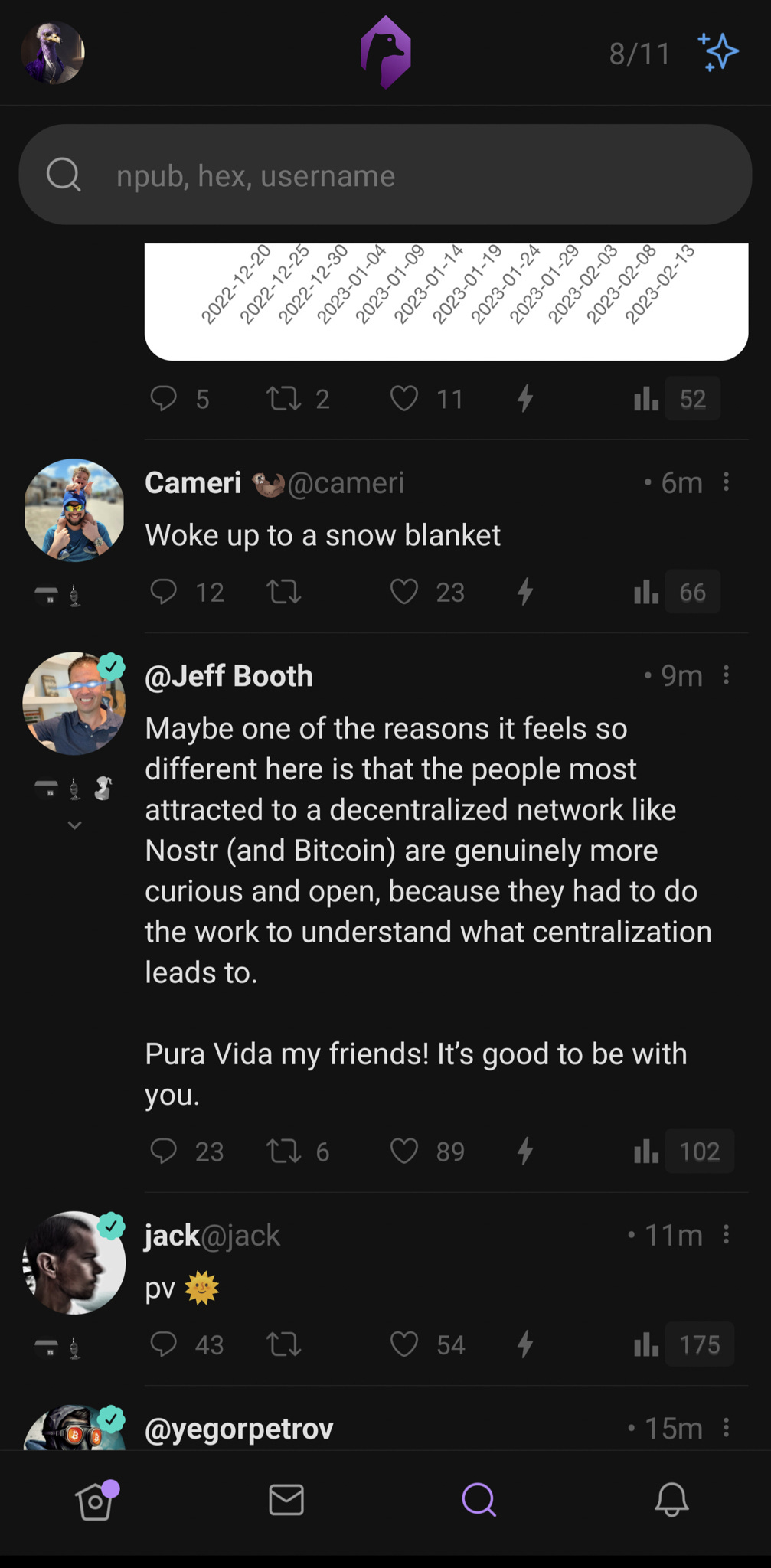
Nostr has already proven itself to be a truly censorship resistant, anonymous speech protocol. After the iOS client Damus was released on the Apple app store, so many Chinese users downloaded the client and flocked to the unrestricted network that the CCP was forced to compel Apple (who happily complied) to remove Damus from the Chinese app store. While the CCP can stop users from downloading one client through the app store, it can't stop users from accessing the Nostr protocol through the myriad other desktop, mobile, and web clients that have proliferated. If you are banned in China, you must be doing something right.
The argument that its code base and developers are protected under the First Amendment is quite clear and compelling. (Publius might well have published the Federalist Papers through Nostr.)
Bitcoin Inscriptions: Enhancing Bitcoin's Usability for Anonymous Speech
The argument for Bitcoin Inscriptions is less obvious, but really no different. And the implications are no less monumental. Bitcoin Inscriptions are a way to embed text or file data into the smallest unit of a bitcoin, one “satoshi” or “sat”. As the Ordinals website explains, this “creat[es] unique Bitcoin-native digital artifacts that can be held in Bitcoin wallets and transferred using Bitcoin transactions. Inscriptions are as durable, immutable, secure, and decentralized as Bitcoin itself.” The inscribed sats can be tracked across transactions through an accounting convention called Ordinal Theory.
The digital artifacts created by the inscribing process have been likened to NFTs on other blockchains. This is because the predominant filetype currently is jpegs or other image files. But, unlike other NFTs, these digital artifacts can contain any MIME filetype, such as mp3s, or even executable code.
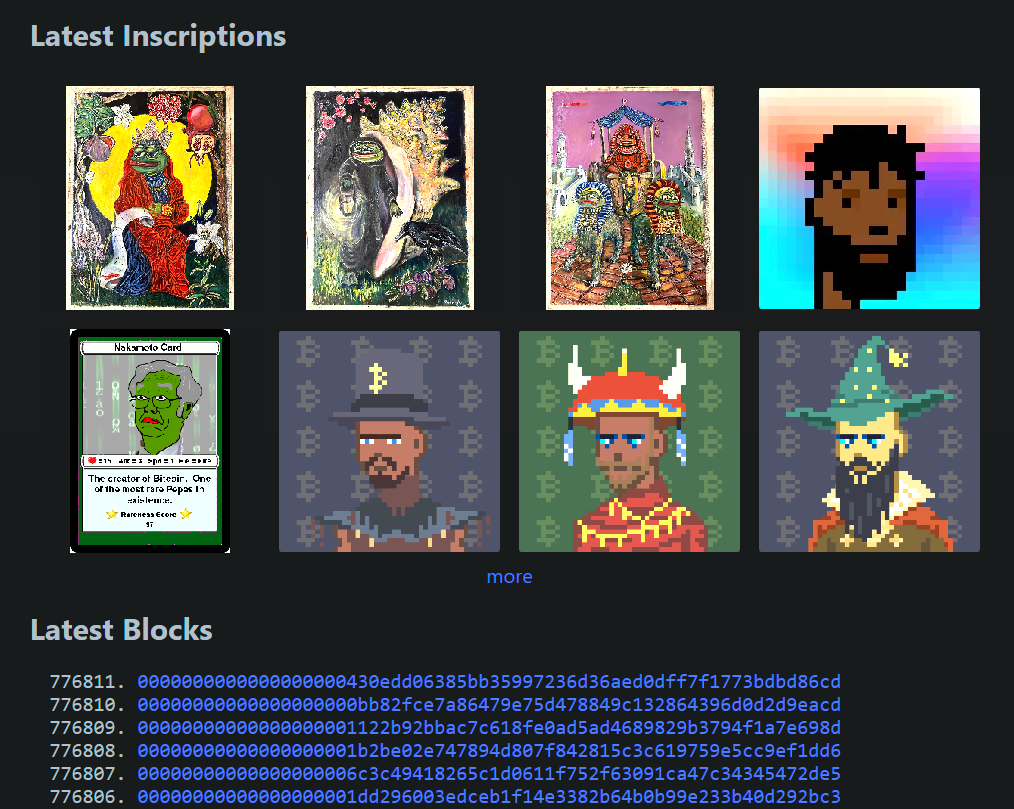
Most importantly, however, Bitcoin Inscriptions differ from NFTs in that the artifacts’ file data can be embedded directly into the bitcoin blockchain. The information placed into a Bitcoin Inscription thus inherits all the immutability and censorship-resistance of the Bitcoin Network.
This ability to permanently place arbitrary data within Bitcoin transactions, forever embedding it in the Bitcoin blockchain, existed before the Bitcoin Inscription project. But Bitcoin Inscriptions make it easier and cheaper to place full file data (up to 4 mb) into individual Bitcoin blocks by leveraging changes made in the last two Bitcoin upgrades, or soft forks (SegWit and Taproot), as Dennis Porteaux explained here.
Before Inscriptions, in 2014, a transaction type called OP_RETURN was added to Bitcoin that enabled arbitrary data, up to 80 bytes, to be included in transactions. The small size made it so that you couldn’t place long strings of text, or most files, directly into the transaction. Instead, you would hash the text or file and place the hash output in the transaction.
For example, the text string of the First Amendment is too long to place within one OP_RETURN:
Congress shall make no law respecting an establishment of religion, or prohibiting the free exercise thereof; or abridging the freedom of speech, or of the press; or the right of the people peaceably to assemble, and to petition the Government for a redress of grievance.
So, we have to hash it. This can be done through any online generator, mobile tool, or desktop command line interface. Running the text through SHA-256 (the Bitcoin proof of work hashing algorithm) produces the following string:
69be9b199c542c56183c408a23d7fd41fc878ec2634be6583db1659fb0e91063
Now we can take that string and include it in an OP_RETURN transaction. I placed the hash of the First Amendment into block 776,390, which you can view through the block explorer mempool.space.
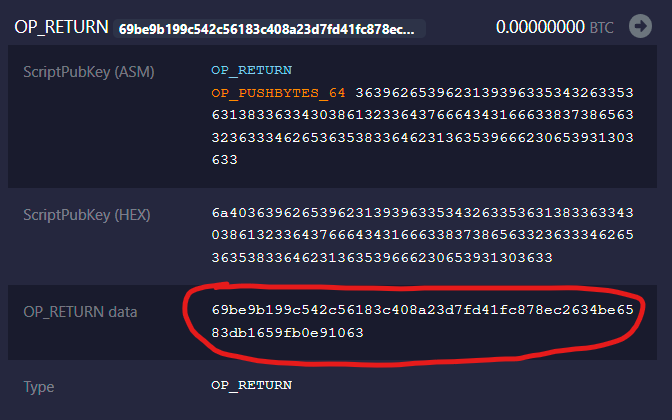
Unfortunately, this hash doesn’t tell a reader very much. SHA-256 is a one-way function, meaning you can’t decode the hash back into text. Instead, the author has to tell you that the hash is the First Amendment, and then you would verify that for yourself by taking the First Amendment and hashing it again, then comparing the outputs. I’ve done that here with a mobile tool:
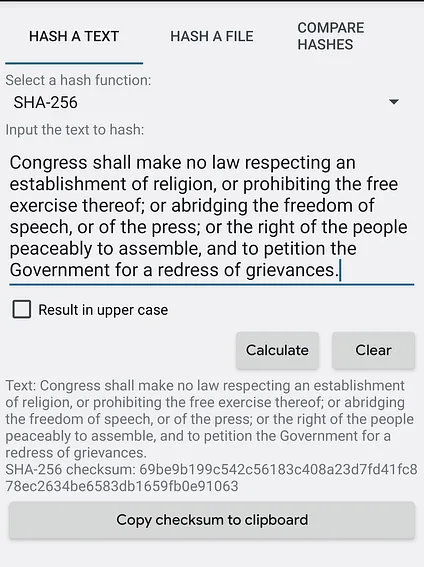
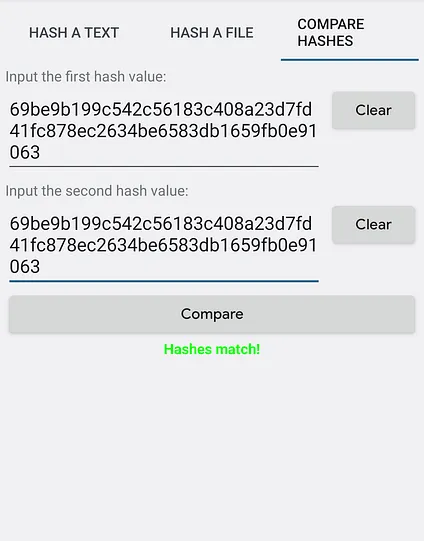
Thus, outside of very short messages, OP_RETURN was really only good for using the Bitcoin blockchain as a timestamping service to prove a document or message existed at a certain time. (Indeed, Satoshi Nakamoto didn’t use the word “blockchain,” but referred to a “distributed timestamp server,” which was necessary to order transactions in time without a centralized mint or bank. Others now use the phrase “timechain” as a more accurate reference to Bitcoin’s distributed ledger.) It’s now an indisputable fact that on February 13, 2023, at 2:51 p.m., EST, the exact text of the First Amendment I hashed existed. Remarkable, I know. But you get the point.
Because communicating through OP_RETURN required so many steps and technical knowledge, as demonstrated above, the Bitcoin protocol was not a great tool for communicating general, non-financial messages to a wider audience. To be sure, messages sent in OP_RETURN, even simple hash strings, are speech entitled to First Amendment Protections. This is because, as the Supreme Court held in Sorrell v. IMS Health Inc., 564 U.S. 552, 570, (2011), the “First Amendment protects even dry information, devoid of advocacy, political relevance, or artistic expression." And hashes, unintelligible strings of numbers and letters, are still protected speech because "a narrow, succinctly articulable message is not a condition of constitutional protection, which if confined to expressions conveying a 'particularized message,' would never reach the unquestionably shielded painting of Jackson Pollock, music of Arnold Schoenberg, or Jabberwocky verse of Lewis Carroll.” Moreover, those hashes do communicate a message, but in the language of math, not English.
But for average people, it was very difficult to understand that such dry data constituted speech. Average people, of course, includes judges who must rule on these legal issues in the first instance with little to no direct precedent to guide their decisions.
Enter Bitcoin Inscriptions. Recall, with Inscriptions, the entire, un-hashed, readable file is in the block. With a simple browser, a reader can pull up any inscription and immediately receive the message, not just the timestamp of the message. For example, with a user-friendly web-app, I was able to inscribe the full text of the First Amendment into block 775,770:

Inscription 39915 is the First Amendment to the United States Constitution, and it is forever part of the Bitcoin timechain.
Because Inscriptions are almost instantly readable and understandable, the average person can quickly grasp that they are forms of speech. There is now a simple, easy to understand example to demonstrate Bitcoin's non-financial communicative use. Again, judges are people too, and they'll be much more likely to understand that Bitcoin is a medium of speech if you show them Inscriptions. In fact, the developer of Ordinals and Inscriptions recently made this point on a podcast with Matt Odell.
The fact that Bitcoin enables non-financial communication directly affects the level of protection its code will receive under the First Amendment.
Laws and regulations that restrict commercial speech receive only "intermediate scrutiny," which is an easier hurdle for the state to clear. I argue Bitcoin is not truly commercial speech because it doesn't "propose a commercial transaction," it communicates and evidences transactions that have already been proposed and accepted between transacting peers so that others who are not parties to those transactions can verify that bitcoins are not being spent twice. But judges operating with a superficial understanding of Bitcoin could reach for an easy heuristic like commercial speech when determining a First Amendment challenge, thereby weakening Bitcoin’s protections.
Prominent examples of non-financial communication through the Bitcoin protocol — like Bitcoin Inscriptions — will make it easier to argue that Bitcoin enables pure speech, which is entitled to "strict scrutiny," a level of protection that almost always ensures restrictive laws and regulations are deemed unconstitutional. It’s hard to argue this is not pure speech entitled to the fullest First Amendment protections:

Because, therefore, Bitcoin Inscriptions enable anonymous, expressive, and non-financial speech, the code for the Inscriptions client is inherently imbued with First Amendment significance, like Nostr and Bernstein's encryption algorithms.
Not only that, but Bitcoin itself is now undeniably imbued with First Amendment significance. This is because Bitcoin Inscriptions are reliant upon and extend Bitcoin's existing code and protocol, and individual inscriptions are forever embedded in the Bitcoin ledger.
Bitcoin Inscriptions have, therefore, strengthened Bitcoin's protections under the Constitution.
The Rubicon Has Been Crossed
Both Nostr and Bitcoin are fully decentralized protocols that enable anonymous speech — a deeply ingrained constitutional value. Anyone can run a Nostr relay without permission to store and transmit notes. Tens of thousands of Bitcoin nodes contain now hundreds of thousands of Bitcoin Inscriptions in their hard drives. That level of decentralization means that even if courts were to rule that these protocols’ code is not protected under the First Amendment, it is impossible to shut them down, or delete, censor, or otherwise restrict the information stored and transmitted through those systems.
There’s no turning back. We’re now in an era of truly unrestricted anonymous speech.
Tip the Author through Lighting Addresses: ⚡bitcoinbrief@getalby.com⚡
